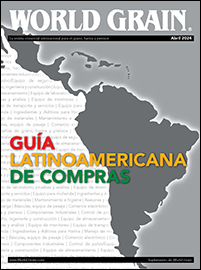The U.K.’s Agriculture and Horticulture Development Board reported a surge in wheat driven by the June 12 USDA World Agricultural Supply and Demand Estimates report.
“It lent a bullish tone to the beginning of the week, which saw new crop wheat futures soar in the U.S. and Europe,” the USDA said in its Market report.
In its Wheat Outlook report, published June 14, the USDA’s Economic Research Service gave the Department’s latest forecast for world wheat production in 2018-19 at 744.7 million tonnes, down 3 million on the forecast made a month earlier and 13.5 million below the previous record.
“The projected decline in global wheat output this month is less than the decline in foreign production, given a 0.2-million-tonne increase in U.S. production,” the USDA said.
For Russia, the agency noted that “both winter and spring wheat production are reduced this month. Untimely dry weather persisted in the western primary winter wheat areas (southwest of the country) during flowering stage of crop development.”
For the E.U., the USDA said that “this month, wheat yields and output are projected lower for Germany and Poland, reflecting pronounced dryness across the countries.”
Movements in world wheat export prices continued to be mainly linked to prospects for 2018-19 crops, the International Grains Council (IGC) said in its Grain Market report at the end of May.
“Price gains in the early part of the month were eroded as the weather turned more favorable in a number of countries,” the IGC noted. “However, crop worries persisted and prices reacted to changeable weather conditions as the month progressed, rising strongly again in the latter part of May. Strength in the dollar had a notable impact on export competitiveness among the major origins.”
“U.S. futures initially rallied to around nine-month highs, but markets had a softer tone by mid-May amid more confidence that overall world supplies would be ample,” the IGC said. “This was underscored by USDA’s first global supply and demand outlook for 2018-19. Nevertheless, continued domestic and global crop uncertainties saw two-sided day-to-day movements in futures in the second half of the month.”
Since its previous report, U.S. Hard Red Winter export prices rose by $9, to $254 fob (Gulf), while Soft Red Winter gained $7, to $230 fob (Gulf). The IGC said that new season July SRW was quoted at around $228 fob (Gulf), up $8 on the month, while Hard Red Winter gained $9, to $254 fob (Gulf).
“Prices in the E.U. often responded to direction in the U.S., with Paris futures climbing to around 10-month highs in the second part of May,” the IGC said. “A weaker euro was seen to be improving export prospects; despite the advance in local futures, grade 1 dollar-denominated export values showed little change in France, at $206 fob (Rouen).”
French new crop (July) traded at around $207 fob (Rouen), $6 higher on the month.
The IGC described nearby Russian milling wheat export values as having edged lower to $211 fob.
“New season (July) prices were underpinned by concerns about poor crop weather, gaining $3 … but at around $202 fob, remained at a discount to spot supplies,” the IGC said.
The IGC also reported that “domestic futures in Australia traded at contract highs on shrinking production ideas as dryness continued to impede planting,” while “improved weather for 2018-19 seeding pressured new season values.”
In its Agri Commodity Markets Research report for May, Rabobank highlighted how global risks had driven wheat prices to 10-month highs, with “threatening weather” across Canada, Australia, the United States and the Black Sea region.
“Despite a backdrop of heavy exportable supplies, this emerging dryness raises concerns of tightening exportable stocks, by 8-9 million tonnes, in 2018-19,” Rabobank said.
Dryness in the Black Sea had unsettled the market, Rabobank said, noting that half of normal rainfall had fallen in central crop areas in the eight weeks before its report was produced. It forecast a decline of 10 million tonnes, to 75 million tonnes, in the Russian wheat crop compared to the previous year’s record.
“This remains well above the five-year average and, if realized, will maintain hefty stocks and lower prices for another year,” Rabobank said. “However, if dryness persists, Russian stocks will erode more rapidly, a factor which poses a more bullish price scenario.”







